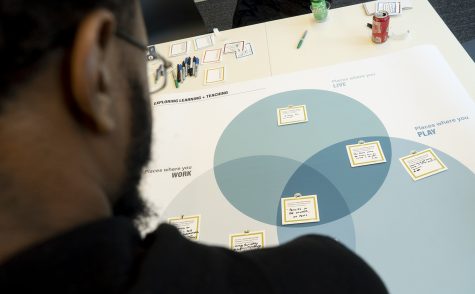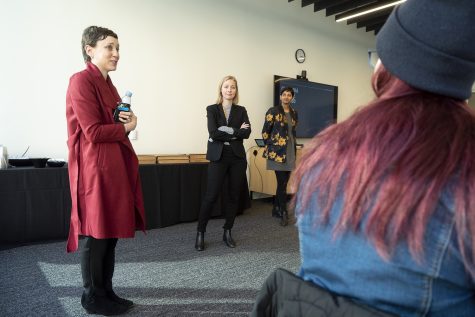Looking to 2030: College seeks input for Master Plan

Music student Dee Daniels shares his memorable learning experience during the Strategic Plan Workshop at the Student Center on Wednesday, Feb. 19.
In 10 years, what do you want Columbia to look like? Should classrooms be set up differently? Should sustainability be more prevalent? Should the curriculum change? The college wants to know.
Through a handful of workshops for faculty, staff and students, Columbia is seeking input on ideas to implement in the Vision 2030 Columbia College Chicago Master Plan, a set of goals the college will prioritize for the next decade.
The plan follows the 2015–2020 Strategic Action Plan heralded by President and CEO Kwang-Wu Kim, which outlined goals in student success; developing a 21st century curriculum; Diversity, Equity and Inclusion; community engagement; optimizing enrollment; and aligning financial resources.
“By 2030, I want it to be really clear that this is the school that a young creative comes to because they want to be successful in the real world,” Kim said in a Monday, Jan. 27 article by the Chronicle. “The key to continuing the growth is to be very mindful of what young people are looking for.”
The biggest accomplishments of the Strategic Action Plan were the construction of the Student Center and the first uptick in enrollment in more than a decade.
To collect input, Columbia is partnering with Gensler, an architectural design firm that partnered with the school for the planning and design of the Student Center.
Gensler Principal architect Meghan Webster and Urban Designer Nicholas Pryor have been working closely with senior administrators to co-create a six-month development review, allowing them to interact with individuals at the college and research the campus environment. This will be carried out through workshops, interviews with departments, shadowing people during their everyday campus routine and a college-wide survey expected to be sent within the coming weeks, Webster said.
Conversations for the review process will center around classroom and workplace environments, sustainability and student wellness, Webster added.
“A big focus of this is user experience,” Webster said. “It’s not about what you want—we’re going to write that down—but more about how you experience the campus as a student, and the things that [we] can adapt and change about the campus in the next 10 years that can really enhance the experience.”
As of press time, two workshops have been held at the Student Center for students, and another two for faculty and staff, to offer their expertise.
During a student workshop on Wednesday, Feb. 19 attended by the Chronicle, only four students attended, including the two Chronicle staffers covering the event.
During the workshop, representatives from Gensler asked questions about the students’ daily schedules and how they interact with Columbia’s campus and facilities. Toward the end, students were asked to write what they thought about the campus and what they want to see implemented in the future.
Isaiah Moore, co-president of the Black Student Union and junior double major in television and cultural studies, said the idea of getting student input is valuable but could be done in a more effective way.
For instance, Moore suggested utilizing student organizations to get the word out, considering the Black Student Union has approximately 50 students at each of its weekly meetings.

Gensler organizers Meghan Webster, Michelle Maher and Amrita Kulkarni welcome students to the Strategic Plan Workshop at the Student Center.
“Partnering with SGA and student organizations can ensure some kind of turnout, from the organizational standpoint,” Moore said. “Really using the students to help you because we want to see Columbia be a better place, as well.”
Regarding what he is looking for from the Master Plan, Moore said student organizations have been searching for a designated space to meet ever since The Loft, 916 S. Wabash Ave., closed and the Black Student Union had to move its meetings to the Library, 624 S. Michigan Ave.
“A lot of other student organizations are looking for places to call home,” Moore said.
Lesley Calvillo, a sophomore animation major, said she misses Frannie’s Café being at 1104 S. Wabash Ave. and hopes to see more comfortable environments like The Loft to relax.
“I do go to the Student Center a lot, too, and that’s really great, but I feel like there still isn’t a place that’s really comfortable if you want to relax,” Calvillo said.
While practicing on the concert hall stage of the Music Center, 1014 S. Michigan Ave., band members of Indigo Flood shared their thoughts about possible improvements to campus.
“Our practice rooms are just old closets that we go into and it’s fine, but I spend most of my time in there,” said Tiago Ribeiro, a sophomore music major. “There’s just so many students now with the new people coming in, so it’s kind of tough to find a practice area.”
Joshua Freehill, a sophomore music major, said he always hears sound bleeding through the walls of practice rooms in the music building.
“There was one time we were practicing and there was a metal band or something, but you could hear everything they were doing through the walls of the building,” Freehill said. “We all deserve the right to make noise as music students because we have to in order to practice.”
Raquel Monroe, co-director of the Academic Diversity, Equity and Inclusion Office and associate professor in the Dance Department, participated in the faculty Master Plan workshop.
“I found it to be a useful exercise,” Monroe said. “Thinking about the way our built environment impacts how we work and with whom we work therefore influences how we work with students.”
Monroe would like to see a space to practice dance with her students that does not have columns in the way of movement.
In terms of low student turnout, Monroe said it is tough to make students aware of these workshops when there are multitudes of other factors at play.
Monroe recommended creating a social media campaign and having class visits to reach more students rather than just sending out email alerts.
Overall, Monroe said she thinks the Master Plan will help the campus community intersect.
“I want the building[s] to help us be interdisciplinary, so that no department is necessarily sectioned off from other departments,” Monroe said. “As we move through space, we’re forced to engage with one another and cross into each other’s spaces.”

